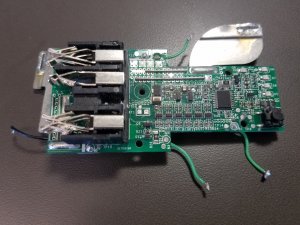Hello, I'm fairly new to batteries and BMS and all that, but after watching a few videos and reading a few articles, I thought I'd try my hand at converting dead NiCd batteries to Lithium. I know I need 5 18650 cells to replace an 18V battery and I know I need a BMS to make sure the voltage doesn't drop too low. I bought a LiPo balancing charger that will work sufficiently. Then on my search for a good BMS setup, I found someone discussing the Lowe's Kobalt 24v batteries. Then I found another reference at this website. For $10 I purchased the 1.5 Ah battery and tore it apart. I was wondering (and hoping) if it was possible to repurpose the 6s BMS for a 5s setup? If I could get the cells (plus an extra) and the BMS for $10 ($20 for 2.0 Ah), I'd be pretty happy. It seems like a lot of the 5s BMS cost $2-10 on their own, so this would make this a very useful endeavor for multiple packs.
I tried to simply remove one cell from the circuit to see what happened and the charge indicator lights indicated it was overly drained, a voltmeter and the charger both indicated 20v at the connection pins, but when trying to discharge, it would not go above .3 A, which based on what I've read about some types of BMS, limiting current is one method of "disconnecting." So essentially it didn't work.



I tried to simply remove one cell from the circuit to see what happened and the charge indicator lights indicated it was overly drained, a voltmeter and the charger both indicated 20v at the connection pins, but when trying to discharge, it would not go above .3 A, which based on what I've read about some types of BMS, limiting current is one method of "disconnecting." So essentially it didn't work.







